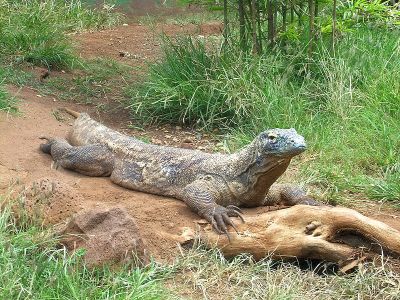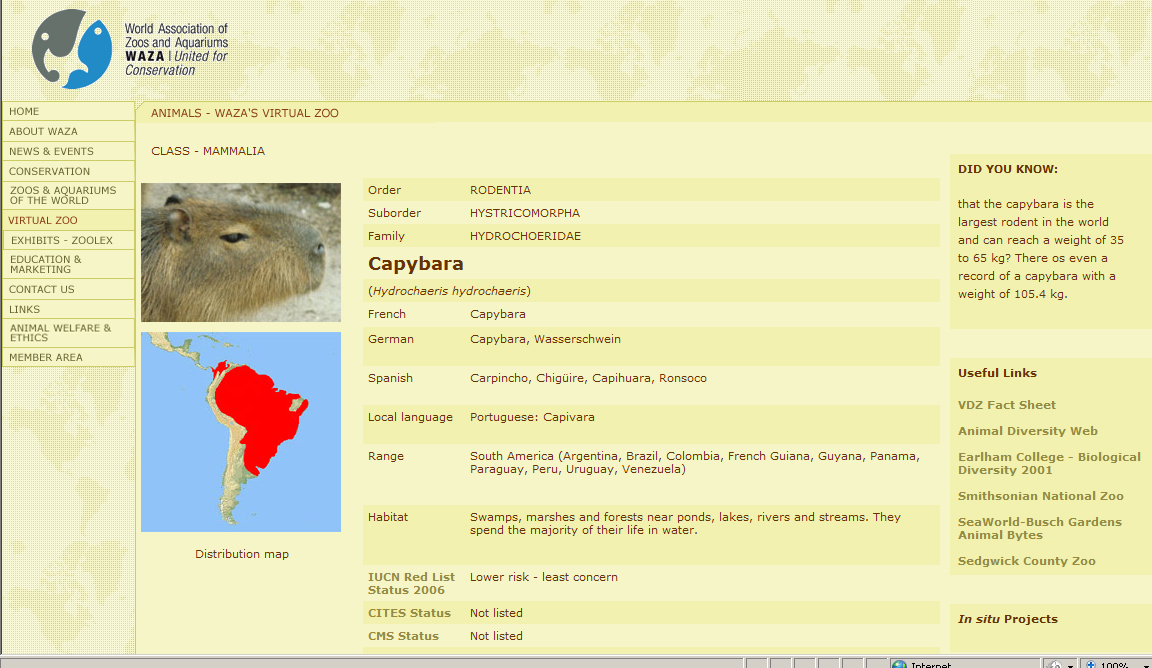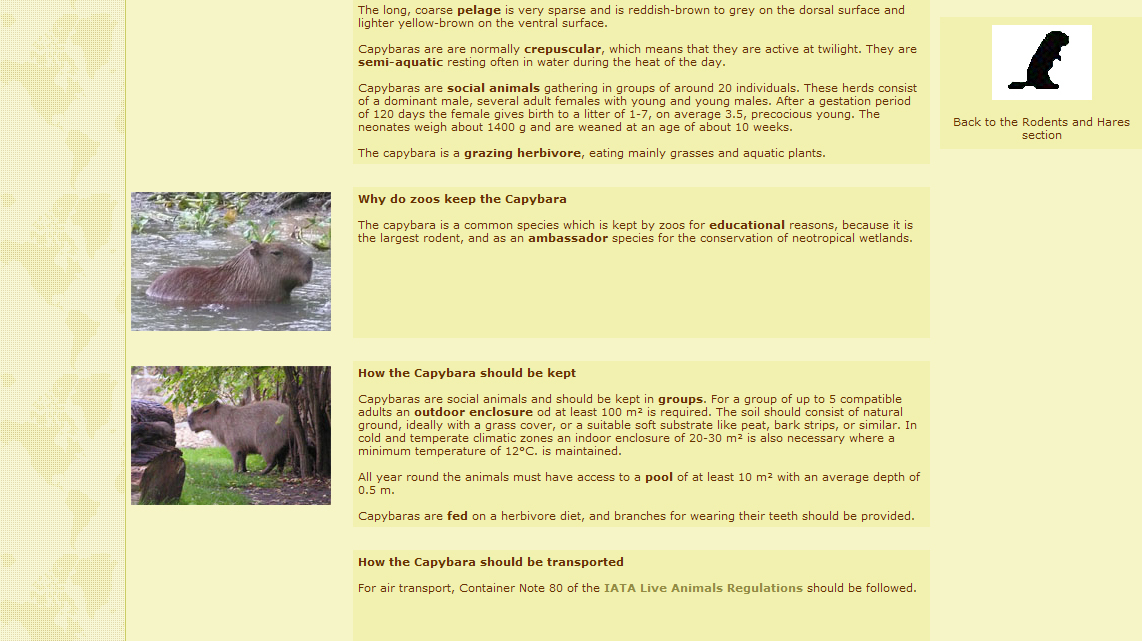Yes, yes. We're behind. Stop chastising and enjoy the light reading all about our favorite real life dragons...Komodos!

For the fact sheet, click here: Komodo SDT AotM March.
My company is just me. And that’s by design. I do not intend to hire employees and I purposefully keep my fees and client volume low. I view it as a complete success, but given the common perception of “business success,” I often wonder if others would agree… In this article, I outline my business strategy of Growing Small as an alternate measure of success.
Believe it or not, many consultants, including yours truly, are actually introverts! Learn the best practices for working with introverts by reading Felis Consulting’s somewhat self-effacing and certainly vulnerable ‘Top Tips for Working with Introverted Consultants.’
As a designer dedicated to the long-term planning of zoos and aquariums, I’ve had to explain the process of master planning many times, and although every zoo and aquarium is different, the best master plans (i.e. those which have been implemented) always follow a similar structure. In this post, we address the most commonly asked questions to help you understand what master planning is, when is the right time to start, and who should be involved.
The city of Lafayette, Indiana has one of the oldest—and best—small zoos in the country. Recent renovations, thoughtful and modern designs, and focusing on providing for their local guests as top priority are a few reasons they are successful.
Zoos and aquariums have a long way to go related to being community assets that are truly reflective of their surrounding communities. Recent discussions in the AZA suggest that instead waiting for ‘best practice’ solutions, that individual organizations must start somewhere acknowledging that our strategies will evolve as we all learn the most productive ways to approach DEAI.
Yes, yes. We're behind. Stop chastising and enjoy the light reading all about our favorite real life dragons...Komodos!

For the fact sheet, click here: Komodo SDT AotM March.
By Guest Blogger Christina Clagett Significance
The purpose of zoos has evolved a great deal over their history. The role of the animal in the zoo has been steadily shifting from a source of objectified amusement to that of ambassadors of their wild counterparts. In the past few decades zoos have increasingly worked beyond their boundaries; researching and reaching out to the native habitats of animals. It is common for reputable zoos to have multiple research and conservation efforts simultaneously underway across the world. The future of zoos and related wild populations depend on these projects, with the ideal result being a combination of efforts inside and outside of the zoo to stabilize and eventually restore native populations.
Zoo visitors of all ages understand that what they are seeing in an exhibit is not the “real thing” despite even the best thematic efforts. However, as they watch a live animal on exhibit, do they understand the role of this ambassador animal in the larger scope of research and conservation? Or do they see a member of a collection there for their viewing enjoyment? The success of conveying deeper meaning varies in zoos across the world; however, a vocal minority opposed to zoological organizations is just one example of a group that currently sees the latter. With so much progress being made in the field directly relating to the future welfare of a species on exhibit, more has to be done to help visitors make a connection between the two. This will add lasting meaning to their visit.
Implementation
For better or worse, attention spans of visitors are getting shorter. Overly wordy interpretive signage hardly commands significant attention and visitors move on quickly if an animal is not engaging at the moment. However, this does open the door for interactive ways to communicate the message. Interactive in this context means any medium from which a user can have a unique experience whether it is a knowledgeable person at the exhibit or a cell phone application. Many of the following strategies are already being utilized to varying degrees in zoos across the world.
In-Person Interpreter
The most simple and cost effective method to convey field efforts to visitors is to have a knowledgeable person, whether it be a trainer or volunteer docent, at the exhibit to literally recount the efforts being made. They could present artifacts sent directly from the field and visitors could have a sensory experience by touching or smelling them. However, it is not practical for a person to be in an exhibit during all operating hours so the message only gets to those visitors who happen to be there at the right time.
Role-Play Areas
A role-play area can mimic field conditions which relate to an exhibit. The scale of these play areas can vary from simple to elaborate or immersive. Most important with this strategy is to celebrate the work being done and encourage conservation by having visitors “play” for the same team as the researcher or conservationist in the field. Viewing areas could mimic the vantage point of the field researcher as the visitor studies the ambassador animal in the zoo. They could collect data with simplified versions of the field research. Real world progress can be chronicled as it happens by sharing information from the field researcher and the game could evolve concurrently with the field work.
Implementation: Technology
The following strategies all depend on the researcher in the field having access to technology to chronicle their work in real-time. Although the information they capture does not have to be shown up-to-the-minute, visitors feel a stronger connection when the content is fresh.
Media Wall/Video Screen
It would be impactful for visitors to see the field work happening on a screen adjacent to the exhibit. For example, having the experience of a close-up encounter while the wild counterpart is visible on a large screen could be very powerful. The researcher could film clips regularly that play on a loop at the exhibit, chronicling recent progress and findings. This would provide a unique experience for even habitual visitors each time as the exhibit avoids becoming static. An added benefit is they come to have an understanding of the field research and will relate it to the animal ambassador in the exhibit.
Social Media
Along the previous topic, the field researcher could take the content they have created and use various social media to share with a larger audience. There could be advertising for this content at the zoo entrances or specific exhibit to spread the word initially and it could be available on YouTube, Facebook or chronicled in a blog. Imagine how it would impact an elementary school science class to follow a particular blog over the school year and see firsthand the real pace of progress; whether quick or painfully slow. Content visitors consume at the exhibit could be reviewed at home on YouTube and shared with friends, convincing them to head to the zoo for themselves.
Animal Apps
As more parents take their children to the zoo with a smart phone or tablet in their bag, the opportunities to share information multiply. Utilizing this technology, all of the data and media collected from the field researcher could be programmed for an experience unique to each guest or group. There are many possibilities to create an interactive experience which combines the exhibit happenings with the field work. Imagine being able access information on demand, and even be able to interact with parts of the exhibit or field researcher with your phone or tablet. In the exhibit, you could control media and interactives with the phone. To go even further, imagine pressing a button on your phone to interact with the animal on exhibit: i.e. controlling an element within the exhibit itself such as a stream current. Not only would this be memorable for guests but could serve as enrichment for the animals as well, as long as it is programmed to prevent getting out of hand. Perhaps there is a limit on how many times such an interactive could be engaged in a given period of time. It should not be ignored that these applications could be a revenue source for the zoos as well.
Game applications which relate to the field work in a similar way to the role play games described earlier could be a huge hit with visitors. Once again, this is something they can engage long after leaving the zoo: it would succeed in keeping guests invested with the animals beyond their visit and create a lasting connection. If kids and parents alike can spend so much time playing games such as “Angry Birds” they could surely get into a game which relates to something they have personally seen or been involved with at the exhibit.
Utilization of an Opportunity
People, particularly children, are often emotionally affected by animals. This is especially true at the moment they connect with an animal in person. We cannot afford to squander the fleeting opportunity of this emotional connection. When a visitor moves on the emotional connection will diminish. We should use the moment to tell them the rest of the story and get them involved and engaged. We as zoo designers should do everything we can to nurture that connection and concern, and integrate the world-wide happenings from the field. We can nurture the formation of future attitudes towards animals and conservation in a more meaningful way than is currently being done on a mass scale.
Christina is a member of the PGAV Zoo Design Specialty Development Team. She has been working at PGAV since 2008. She has a Masters Degree in Architecture from Kansas State University, and is especially proud of her work on the currently under-construction Sea Lion Sound at the St. Louis Zoo.
So, much like the rest of the world, even a professional development team runs a little late. Its April, and we're still working on our submission from March. And, apparently, I am more behind than everyone since I am just now posting our Animal of the Month from February! Without further adieu...Here is your Animal of the Month for February 2011: Elephants.
People are always floored when they learn what I do for a living. I don't blame them. It's not like high school guidance counselors are pushing kids to become zoo designers or aquarium architects. There are no high-profile television shows about zoo designers, no yearly review of the best zoo design schools at the best price.

Ultimately, this lack of awareness about our field brings questions. And one that is always, guaranteed to come up is 'where did you learn to do this?' When I describe my homemade educational program achieved through determination, passion and a plucky ingenuity, indelibly, my listener almost always appears disappointed with my answer.
So, in an effort to reduce the looks of disappointment that my fellow zoo designers must endure, I've introduced a new educational, career development program within PGAV. This program is called the "Specialty Development Group (SDT)."
At PGAV, we have many specialists: ride designers, green designers, interpretive & storyline developers, resort designers, among others. And most of these specialists learned their trade through their own plucky ingenuity and years of experience. But, we have many young people at PGAV as well. People who have a passion for destinations like theme parks, aquariums and zoos, but who may not have had the chance to pursue a specialty in school due to strict program requirements.
In an effort to fully develop these young designers, we've decided to actively teach them, rather than hope they pick up the nuances of these specialties through on the job training. The Zoo Design SDT which I lead is the pilot program. We have a small group of three trainees, myself as leader, and a VP, who has over 20 years of experience in the animal exhibitry field.
We meet once a month for about an hour. In this time, we discuss any news that we've found interesting over the last month, including project news or world zoo / aquarium happenings. We usually have one person give a quick site visit presentation (they are required to visit 3 zoos or aquariums over the yearlong course), then delve into the monthly discussion or lecture.
The monthly topics are pre-determined via syllabus and have been chosen and arranged to allow a logical flow from general zoo design philosophy into specifics, like LSS design and enrichment. This portion of the program is very much like a class, with required readings, in-meeting activities, discussions, formal lectures and guest speakers.
Beyond these meetings, we go on field trips together, and we create a monthly Animal of the Month info sheet to be shared with the entire PGAV office. These sheets cover everything from the basics (animal size, conservation status, behavior, social structure) to husbandry requirements and recommendations to the world's best exhibits.
The participants are also required to write two papers during the year. The first, a simple white paper, is open to any topic of interest to the participant, limited only to the subject of zoo or aquarium design. The second, and final project, is a paper addressing the future of zoo design--a topic of great interest to everyone in zoo design.
Of particular note, the SDT is not supposed to function as a class. Everyone attending the meetings must partake in the activities and homework. So, as leader, not only do I create the lesson plan and lectures, but I also do research for the Animal of the Month info sheets, write papers, and present on site visits. In this way, not only do the newbies learn, but the experienced zoo designers continue to learn as well.
Personally, I've found the SDT has renewed my passion and required me to not site idly by, as is so easy to do as a professional. This type of professional development requires me to evaluate day to day work, to think more deeply about philosophy and ethics and about the long-term implications of everything we do as designers.
Even more, I'm so proud of our participants who, despite a very taxing workload, are able to attend meetings regularly, excitedly share experiences, and think critically about the topics we discuss.
I'm very proud to be leading the charge to help educate our future zoo design leaders and hope other professionals at zoo design firms take advantage of our experiences with this issue.
If you are interested in our program description or syllabus, please email me directly. I'm glad to share!
Yesterday, Wordpress (the website that allows me to bring this blog to you) sent me an e-mail suggesting that I write a post addressing “the bravest thing you’ve ever done.” It struck me that I could apply that question directly to my profession, as often bravery is at the heart of design. To be “brave”, according to Dictionary.com, means:
1. To meet or face courageously: to brave misfortunes.
2. To defy; challenge; dare.
How often do I meet or face courageously? I might generously answer: daily. Some might say just getting out of bed can be an act of courage. But that’s not what we’re talking about here. Daily, as design professionals, we must make decisions. We must choose the width of a path, the height of a wall, the length of a beam. We must decide how to communicate our ideas to our peers and to our clients. We must be courageous to suggest our deepest thoughts to those who are capable of shooting us down with a shake of the head, crushing our hours of glorious contemplation in a split second. We must speak our minds and forge a path. As designers, some might argue, requires courage daily. Not to mention braving misfortunes.
But I’m more intrigued by the second definition. To defy. To challenge. To Dare. How often do we actually reach those lofty heights? How often do we truly put our necks out-- suggest something contrary to our clients’ preconceived notions; contrary to our bosses’ well-intentioned strategies? Not often, I’d guess.
As I’ve said before, design, especially zoo design, tends to push forth, birthing innovation once in a blue moon, only to then regurgitate and spew forth a lesser and lesser version of that once impressive original concept. Instead of continually challenging our designs, instead of continually working to improve the previous iteration, to learn from our mistakes and successes, we far too often just simply pull out examples and drawings from the last time we built that barrier or concepted that raptor exhibit, and copy. Copy. Copy.
So as I consider the question ‘What is the bravest thing I’ve ever done?’ I realize, embarrassingly, I haven’t done it yet.
 AZA has not published the new husbandry guidelines for many species, and the previous guidelines were for mammals only. The International Wildlife Rehabilitation Council has published their own set of husbandry guidelines specific to rehabbing wildlife. However, these guidelines can be very useful, especially in reference to bird and reptile species, when programming exhibit spaces.
Download the guide here, or check out the Resources tab on our website.
AZA has not published the new husbandry guidelines for many species, and the previous guidelines were for mammals only. The International Wildlife Rehabilitation Council has published their own set of husbandry guidelines specific to rehabbing wildlife. However, these guidelines can be very useful, especially in reference to bird and reptile species, when programming exhibit spaces.
Download the guide here, or check out the Resources tab on our website.
Through my work, I am always looking for resources explaining the simple basics of an exhibit for a specific species. Recently, I stumbled upon the World Association of Zoos and Aquariums' (WAZA) Virtual Zoo.

Here, you can search per species for info on exhibit sizing, husbandry, enrichment, and species behavior. This is an excellent starting point or supplement to other exhibit resources. Check it out here. I've also added the link to my Resources page.


atlantis-aquarium
It doesn't exactly roll off the tongue, but multi-disciplinary integration in tourism attractions continues to roll forward as a newly emerging trend. Discussed before purely as the evolution of 'science-based institutions', this trend is finding its way into all forms of tourism destinations.
Consider Atlantis Resort in the Bahamas and Dubai. Not only are these places over the top resorts with beautiful beaches and luxurious appointments, but they've integrated a themed water park as well as an aquatic life park into their campuses. Aquariums are found throughout the properties, and not just typical ho-hum aquariums either; we're talking Aquarium! aquariums. Much like Discovery Cove, visitors can take part in swimming with dolphins as well as enjoying other animal attractions, such as a shark tank and jellies. They've taken a resort and integrated a science-based institution. However, Atlantis is not the focus of this post.

atlantis-waterslide
Recently, in my work, we've been spending a lot of time making fun and beautiful places without stepping back to realize what it is we're really doing; without taking time to truly translate our actions into theory from which everyone in our profession can learn. That is what this post is about. Refreshing our memories about multi-disciplinary integration.

museum_of_life_l
Its happening all around us. Theme parks more seriously integrating conservation issues. Zoos incorporating science-center interactives which are about more than just the size of a polar bear's paw. Aquariums introducing land-based animal habitats. Subtle changes, yes, but all moving toward the ultimate in end goals...creating a one stop shop for science, education, AND entertainment. However, in the end, I do believe these institutions will filter out into two sects: those based on science and education (ie zoos and aquariums now), and those based on play (ie theme parks and children's museums now).

ss_brookfieldzoo-hamill
Some thoughts on what we'll see in the coming years:
Zoos (and possibly aquariums) utilizing gentle, family ride systems to introduce new ways to experience animals
More Atlantis-style resorts with focus on conservation and local habitats, including breathtaking animal habitats presented in ways not seen in zoos and aquariums
Science centers across the board becoming Life Science centers by including animal exhibits
Theme parks spending millions to incorporate Educational elements, either as stand alone attractions or as enhancements to rides and shows

jacksonville-bamboo
Jacksonville Zoo recently opened a new attraction, Asian Bamboo Garden, being touted as a 'garden' first, and 'exhibit' second. The attraction features nearly 2.5 acres of Asian gardens, with a small Komodo dragon exhibit tucked away into one corner. The Zoo focused on botanicals for this project, rather than zoological. This is rather extraordinary, if you think about it. Concept design always begins with the question: What's marketable? Projects are built to get folks through the door. Jacksonville is saying with this project, gardens are profitable. Generally, to me, zoos that call themselves 'zoos and botanical gardens' do so simply because they have beautiful grounds, not because they ever intend to add new attractions based on gardens. However, Jacksonville Zoo and Botanical Garden has done just that, truly illustrating a multi-disciplinary integration in the direction of science.

columbus-zoo-boat
And, finally, Columbus Zoo. Through a series of moves that appears to be an effort to shift almost 180 degrees from a science-based institution into a mini-resort, the Zoo has announced the initiation of a feasibility study on adding a hotel to the already massive complex. Recently, the zoo added a golf course and a water park (check out their fun website). Considering the Zoo is actually a zoo and an aquarium, the complex is quickly becoming a major multi-disciplinary destination, with the focus shifting from science to play. Columbus Zoo again illustrates the emergence of multi-disciplinary integration. I'm extremely confident that as we move forward in the evolution of science-based institutions, we'll see many, many more of these kinds of integrations.
Just about every time we start a new master planning project, we ask ourselves, "What are our guests' favorite animals?" Finally, we've decided to find out for ourselves. Knowing the popularity of an animal helps designers plan parks by understanding which animals will act as draws for guests through the site. It also helps the parks prioritize implementation of renovations and/or additions of new animals to take full advantage of revenue and admissions increases.
Be a part of helping plan future zoos, theme parks, and aquariums by letting us know which is your favorite animal!
[polldaddy poll=1361950]